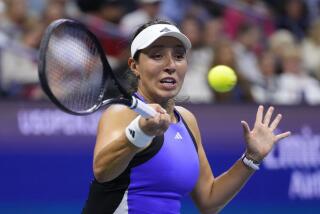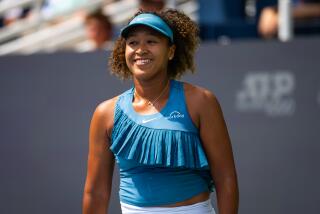Tennis : At 17, Bassett Strives to Be No. 1, but Sheâs in No Hurry
Tennis promoters, realizing that Martina Navratilova and Chris Evert Lloyd canât keep hitting forehands forever, have acknowledged the need to find somebody new for the public to love.
Wanting to keep the seats in their stadiums--along with their coffers--filled, they have peered speculatively into the future of womenâs tennis.
And, they have seen Carling Bassett.
Bassett has the proper credentials: blonde, good-looking, buoyant personality, winning baseline game, daughter of multimillionaire sports owner John Bassett. She is, as they say, marketable.
So, it was with much excitement that Bassett checked into last yearâs U.S. Open and checked out with a semifinal berth at age 16, knocking off Hana Mandlikova along the way. It was the coming of age of Carling Bassett. A star was born.
Alas, the excitement hasnât lasted. In the 11 months since, Bassettâs on-court results have resembled a series of topspin lobs--up and down, up and down. Her current ranking rests at the ho-hum level of No. 18.
The tennis media have viewed this as a major disappointment. They wonder, what ever happened to Carling Bassett?
Bassett responds with another question.
âHey, whatâs the big deal?â she says. âIâm 17.â
Of course, Tracy Austin won the U.S. Open when she was 16. Andrea Jaeger was a 15-year-old semifinalist at the same tournament.
But Bassett has carefully noted the progress of both careers. Austin, at 22, is off the circuit because of a series of injuries. Jaeger, beset by burnout and shoulder ailments, is in the initial stages of a comeback at age 20.
Bassett is trying to learn from history.
âIt would be nice to keep getting to the semis of big tournaments,â she said. âBut what happens when youâre 18 or 19 and youâre expected to win? Whatâs left when youâre 20 or 21? Maybe, in the long run, you donât have such a long run.â
Bassett said she sympathizes with those who have spun out in the short run.
âYou have to enjoy the game,â she said. âThe trouble comes in with the parents and the pressures they put on the players. Itâs like they turn professional when their child does.
âThe pressure gets to be so much for some players that when they lose a match, they do stupid things. Like, they wonât talk to anybody.
âI want to be No. 1--very much so. But Iâm not going to put pressure on myself until I know I can actually do it.â
Bassett said sheâs still a ways away. Navratilovaâs retirement would help. So would an improved serve-and-volley game, which Bassett is working on.
And, she admitted, her progress has been slowed in 1985 by some off-court concerns, among them her fatherâs struggle against cancer. âThere have been a lot of things that have taken away from my tennis,â she said. âThere are a lot more important things than tennis.â
Although menâs tennis continues to be revitalized by new faces with star potential--Boris Becker, Mats Wilander, Pat Cash--the womenâs game has been stagnant for most of the 80s. Navratilova and Lloyd have been holding the torch almost as long as the Statue of Liberty.
Maybe Gabriela Sabatini will provide the new marquee appeal. Or maybe Zina Garrison.
Or maybe it will be a blonde, 17-year-old Canadian baseliner whoâs already acting in television commercials and modeling clothes for New Yorkâs Ford Agency.
Promoters would like that. But Bassett, who would have something to do with such a project, warns them not to hold their breath. She plans on taking her time about this.
âItâs hard not to think about Bjorn Borg,â Bassett said. âCan you think of what it would be like to win week after week, to win every tournament when youâre 17, 18, 19? âI think Mats Wilander has the best attitude. He made the greatest quote I ever heard, when somebody asked about winning the French Open and then sometimes not doing well (in other tournaments). He said, âI donât want to retire when Iâm 26.â He doesnât want it all at 20 or 21.
âItâs tremendous to be No. 1, but when you get there so fast, what more is left after 21? Even Martinaâs talking about retiring, and it wasnât until she was 23 or 24 when she really started winning. I want to continue to play tennis for a long time.â
Rivalry In the Making: After she blew leads of 5-2 and 5-1 in a straight-sets defeat against Claudia Kohde-Kilsch last week at Manhattan Beach, Hana Mandlikova grumbled that the winner was âlike a machine . . . sheâs programmed.â
That didnât set too well with Kohde-Kilsch.
âI think thatâs wrong,â Kohde-Kilsch said after reading Mandlikovaâs comments in the newspapers the following day. âIâm not a machine, Iâm not playing the same situation always the same way.
âA machine is Evert or Austin or Jaeger, somebody who hits two-handed backhands for hours. I am not a machine. I donât know why she (Mandlikova) would say that. I understand she was not very happy when she lost.â
To be continued.
Nervous Time?: The women have been talking bravely ever since the Battle of the Sexes doubles match was officially scheduled for Aug. 23 in Atlantic City. Vitas Gerulaitis and Bobby Riggs donât have a prayer, Martina Navratilova and Pam Shriver have been saying.
Lately, however, Shriver has admitted to one worry about the showdown.
âThereâs some concern that Martina and I will not have played doubles together since Wimbledon,â she said. The two were to have played in the Manhattan Beach tournament, but Navratilova was forced to withdraw because of a pinched nerve in her neck.
âI think we should win,â Shriver said, âbut it could be more difficult than we originally thought.â
More to Read
Go beyond the scoreboard
Get the latest on L.A.'s teams in the daily Sports Report newsletter.
You may occasionally receive promotional content from the Los Angeles Times.










